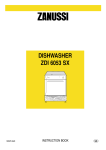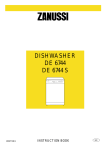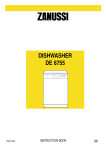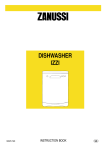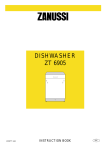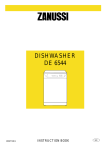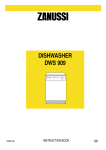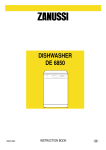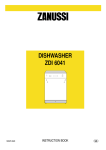Download Zanussi DA 6473 Instruction manual
Transcript
LAVAVAJILLAS DISHWASHER MÁQUINA DE LAVAR LOIÇA DA 6473 E GB P Manual de instrucciones - parte 2 2 Instruction book - part 2 12 Instruções de utilização - parte 2 22 Attention The appliance which you have just bought is supplied not only with this instruction manual, but also with a Warranty Card Certificate, on the back of which are written the relative conditions. Please fill in the necessary details on the Card Certificate and send it to the Zanussi Centre relative to the area in which the appliance is to be installed, within twenty days of the date of purchase. (See list of Zanussi network centres). We congratulate you on your choice. Carefully read this instruction manual and follow attentively the recommendations it provides, and thus benefit from years of excellent service. The appliance which you have just purchased has been very accurately controlled throughout the entire manufacturing process. Nevertheless, should any problem arise during usage, whether it be during the warranty period, or when such period has expired, please directly contact your nearest Zanussi Service Centre. The address and telephone number of said Centre can be easily found in the enclosed List or by looking in the telephone directory, under Zanussi. Our Zanussi Service Network is at your complete disposal, to serve you with maximum speed and efficiency, all you have to do is call. The products In order to obtain a good wash, it is necessary to use detergents specially designed for dishwashers. To ensure that your dishwasher functions perfectly, Zanussi recommends using Calgonit System, a unique and complete product, tested by millions of householders. Calgonit System includes Calgonit detergent, rinse aid, salt, machine detergent and Citro-Fresh. It is able to fulfil the main requirements for clearing both the crockery and the machine itself. 12 Description of the appliance 15 1 2 14 13 3 12 11 10 4 5 6 9 8 7 IN69 1. Water hardness adjustment 11. Lower spray arm 2. Levelling spacers 12. Upper spray arm 3. Upper basket stop 13. WRD detergent dispenser 4. Salt container 14. Upper basket 5. Large filter 15. Worktop 6. Detergent dispenser 7. Control panel 8. Rating plate 9. Rinse aid dispenser 10. Central filter 13 The control panel 1. On/Off indicator light 7. Programme sequence indicator As the programme progresses, the programme selector dial turns, to show the phase in the wash programme the appliance has reached. 2. On/Off push button Prewash / Rinse and Hold Wash 3. Main wash temperature push buttons (50° - 70°) Cold rinse Hot rinse Drying 4. Half load push button By pressing this push button washing can be confined to the only lower basket. 8. Programme guide This is useful when only a few dishes need washing (see "Washing programmes" chart). Remember to load all the dishes only in the lower basket. 9. Programme marker 5. Door handle 10. Programme selector dial 6. Salt indicator light Illuminates when the salt has run out, to remind you to refill the salt container. (See "Setting the water softener" - "Instruction book" part 1). 14 Washing programmes Programme Intensive 70°C WRD Normal 65°C with prewash * Bio 50°C with prewash Normal 65°C no prewash * Bio 50°C no prewash ** Quick 50°C Rinse and Hold Degree of soil and type of load Heavy soil. Crockery, cutlery, pots and pans Normal soil. Crockery and cutlery Normal soil. Crockery and cutlery Light soil. Crockery and cutlery Light soil. Crockery and cutlery Light soil. Crockery and party crockery Any. Partial load (to be completed later in the day). Starting position of the programme selector Required push buttons wash On/Off + 70° A A On/Off A On/Off + 50° Half load (Quick) * Light soil. Crockery and cutlery Light soil. Crockery and party crockery 20 g 25 g 25 g 30 g prewash 10 g Hot prewash Main wash up to 70°C 2 cold rinses 1 hot rinse Active drying 5g Cold prewash Main wash up to 65°C 1 cold rinse 1 hot rinse Active drying 5g Cold prewash Main wash up to 50°C 1 cold rinse 1 hot rinse Active drying / Main wash up to 65°C 1 cold rinse 1 hot rinse Active drying B On/Off B On/Off + 50° 30 g / Main wash up to 50°C 1 cold rinse 1 hot rinse Active drying C On/Off + 50° 30 g / Main wash up to 50°C 1 cold rinse 1 hot rinse / 1 cold rinse (to avoid food scraps from sticking together). / D On/Off B On/Off + 20 g / Main wash up to 50°C 1 cold rinse 1 hot rinse Active drying On/Off + 20 g / Main wash up to 50°C 1 cold rinse 1 hot rinse Half load (Normal no prewash) Recommended Cycle description quantity of detergent C Testing programme for EN 50242. (see "Hints for test centres"). ** This is a special programme for quick washing a full load of lightly soiled dishes, glasses and crockery (except pots) so that you may re-use them promptly. 15 Operating sequence 1. Check the filters 9. At the end of the washing programme Ensure that they are clean and properly positioned. (See "Maintenance and cleaning" - Instruction book - part 1) At the end of the programme the dishwasher will automatically stop. The On/Off indicator light remains on until the On/Off push button is depressed. 2. Check that there is rinse aid and salt 10. Switch off the dishwasher (See "Instruction book" - part 1) Switch off the dishwasher by pressing the On/Off push button. 3. Load the dishes Wait 15/20 minutes before opening the dishwasher’s door; in this way you will avoid burning yourself when removing the dishes and avoid also the damage of the nearby furniture caused by the escape of steam. Remove any scraps of food. Pull the lower basket out and arrange the saucepans, plates and cutlery in it. Pull the upper basket out and arrange the plates, saucers, glasses and cups etc. in it. Empty the lower basket first and then the upper one; this will avoid water dripping from the upper basket onto the dishes in the lower one. Slide the baskets back into the machine. 4. Ensure that the spray arms can rotate freely When the washing programme has finished, it is recommended that the dishwasher is unplugged and the water tap turned off. In general it is not advisable to open the door while the machine is working; if the door is opened however, a safety device ensures that the machine stops. 5. Measure out detergent Add the detergent into the dispenser according to the dosage quantity given in the "Washing programmes" chart. Close the detergent dispenser lid. Important! Care must be taken if the door is opened during the hot phase or immediately after a programme has finished, as steam may escape. 6. Set the programme The selection of the programme occurs with the door partially opened. Turn the programme selector dial clockwise until the letter of the programme you wish to select corresponds with the programme marker on the control panel. If necessary select the temperature of the main wash (or a half load programme) according to the instructions in the "Washing programmes" chart (see "Required push buttons"). 7. Start the programme Depress the On/Off push button. The On/Off indicator light will come on and the machine will start. If you wish to interrupt the washing programme at any time press this button again. 8. Close the dishwasher door 16 Using your appliance Loading your appliance Before placing dishes in the machine, remove any scraps of food, to avoid clogging the filters and consequently reducing the performance. Do not load very small items which can fall through the baskets. UI48 The lower basket The lower basket is designed to take saucepans, lids, plates, salad bowls, cutlery etc. Large dishes and lids should be arranged around the edge of the basket, ensuring that the upper spray arm can turn freely. The two rear rows of prongs on the lower basket can be easily lowered to allow you to load pots, pans and bowls. To lower the prongs: UI21 - Slightly pull them upwards and let them drop down (see picture). - To bring them back to the standing position, just pull them up again. UI85 17 UI18 The cutlery basket Long bladed knives stored in an upright position are a potential hazard. Long and/or sharp items of cutlery such as carving knives must be positioned horizontally in the upper basket. Take care when loading or unloading sharp items such as knives. Cutlery should be placed in the removable cutlery basket with the handles facing downwards. If the handles protrude from the bottom of the basket, obstructing the lower spray arm, load the cutlery with the handles facing upwards. Mix spoons with other cutlery to prevent them from sticking together. UI63 Silver cutlery tends to go black if mixed with steel cutlery. Place it in the cutlery basket separate from the others. For best results we recommend you to use the cutlery grids provided (if the size and dimensions of cutlery allow it). The cutlery basket is in two parts which can be separated to give greater loading flexibility. To separate the two parts, slide them horizontally in opposite directions and pull them apart. To reassemble, reverse the procedure. UI62 The upper basket The upper basket is designed for plates (dessert plates, saucers, dinner plates of up to 25 cm in diameter), salad bowls, cups and glasses. Arrange items on and underneath the fold-down cup racks so that water can reach all surfaces. Light items (plastic bowls etc.) should be loaded in the upper basket and arranged so they do not move. In case that plates are loaded in the upper basket: US47 load them starting from the rear posiitons of the basket; tilting them slightly forwards and avoiding the front positions near the door. Before closing the door, ensure that the spray arms can rotate freely. US71 18 Adjusting the height of the upper basket If washing very large plates (over 27 cm and up to 32 cm in diameter) you can load them in the lower basket after moving the upper basket to the higher position. Attention! Never lift or lower the basket on one side only. To move to the higher position proceed as follows: 1. Pull out the basket until it stops. 2. Carefully lift both sides upwards until the mechanism is engaged and the basket is stable. RC04 When the top basket is in the higher position it will only take plates up to 20 cm in diameter and you will not be able to use the cup racks. To lower the basket to the original position proceed as follows: 1. Pull out the basket until it stops. 2. Carefully lift both sides upwards and the allow the mechanism to drop back slowly, keeping hold of it. After loading your machine always close the door, as an open door can be a hazard. 19 Hints for test centres Before starting any test it is necessary to fill completely with salt the salt container and with rinse aid the rinse aid dispenser. Test standard: EN 50242 Reference programme: Bio 50°C with prewash Load: 12 standard place settings Rinse aid selector: position 5 Detergent dosage: 25 g in the dispenser 5 g on the dispenser lid Arrangement lower basket Arrangement upper basket Arrangement cutlery basket Technical specifications Dimensions Width Height with worktop Height without worktop Max depth Max depth with open door Electrical connection Motor rating during wash Power of heating element Overall power Voltage Water supply pressure Minimum Maximum Water supply connection Water cold/hot Capacity 60 cm 85 cm 82 cm 63.5 cm 115.2 cm 230 V - 50 Hz 200 W 2100 W 2300 W 50 kPa (0.5 bar) 800 kPa (8 bar) max. 60°C 12 place settings 20 Fitting under a counter (kitchen worktop or sink) By removing the machine’s worktop, you can install it under a close fitting sink unit or a pre-existing top, providing the dimensions of the recess correspond to those shown in the picture. 820 570 Proceed as follows: - Remove the machine’s worktop by unscrewing the two rear retaining screws, pull from the front and slide out the rear slots, lifting the worktop. 600 Insert the machine after adjusting height and levelling with the adjustable feet. When inserting the machine, ensure that the water inlet and drain hoses are not kinked or squashed. IN05 Levelling Good levelling is essential for correct closure and sealing of the door. When the appliance is correctly levelled, the door will not catch on the levelling spacers on either side of the cabinet. If the door does not close correctly, loosen or tighten the adjustable feet until the machine is perfectly level. The WRD detergent dispenser If the programme has a prewash add the required detergent in the WRD detergent dispenser, located in the centre of the upper basket. Check that the WRD is not clogged with detergent residue. If necessary rinse it under running water after having removed it from the basket by twisting it anticlockwise and pulling it upwards. DE13 Fasten it back onto the support by turning it clockwise. Never use your dishwasher without the WRD dispenser. Since WRD also ensures correct distribution of the water to the upper spray arm, running the dishwasher without it will impair the washing results. MA11 21 - 600 From the Electrolux Group. The world’s No.1 choice. The Electrolux Group is the world’s largest producer of powered appliances for kitchen, cleaning and outdoor use. More than 55 million Electrolux Group products (such as refrigerators, cookers, vacuum cleaners, chain saws and lawn mowers) are sold each year to a value of approx. 14 billion USD in more than 150 countries around the world. 152976 25/1 1 09 /01












